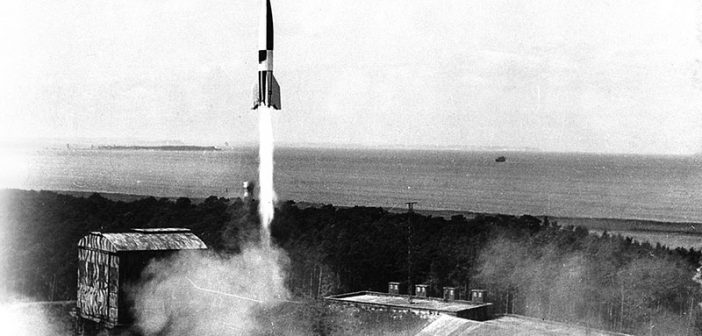Today on Oct. 3, 1942 — The space age is born. After three unsuccessful tests, the Germany’s V-2 rocket makes its first flight from Peenemunde on the Baltic Coast to become the world’s first ballistic missile. The 45-foot-tall, 13.5-ton rocket reached an altitude for more than 52 miles and covers 118 miles before crashing back to earth.
The V-2 –Vergeltungswaffen 2 or Retribution Weapon 2 — was designed by a team led by Werner von Braun and intended to carry a one-ton conventional warhead a distance of up to 200 miles. Powered by an engine that burned ethyl alcohol-water and liquid oxygen, the V-2 could achieve a maximum speed of 3,500 mph, and was traveling nearly 1,800 mph when it returned to earth.
In a speech to the Peenemunde team after the first successful flight, the chief of the German rocket program Gen. Walter Dornberger said: “We have invaded space with our rocket and for the first time. We have used space as a bridge between two points on the earth; we have proved rocket propulsion practicable for space travel. This third day of October, 1942, is the first of a new era of transportation, that of space travel.”
The rockets were to have been built at Peenemünde, but the production line was moved after an allied attack dubbed Operation Hydra. The new underground facility more than 500 kilometers away known as Mittelwerk, there forced labor built 5,200 if the missiles. More than 3,000 were fired, estimated to have killed more than 9,000 people. Thousands of forced laborers from the nearby Mittelbau-Dora concentration camp died either building the underground facility or the rockets.
After the war, about 100 German rocket scientists including Dornberger and von Braun emigrated to the United States along with dozens of rockets, settling at Redstone Arsenal in Huntsville, Alabama, where they began work for the US Army. They tested the rockets at White Sands in New Mexico.
The V-2 was the first step in both the US and Soviet space programs and numerous examples survive in museums around the world, including the National Air and Space Museum as well as the National Museum of the United States Air Force.




